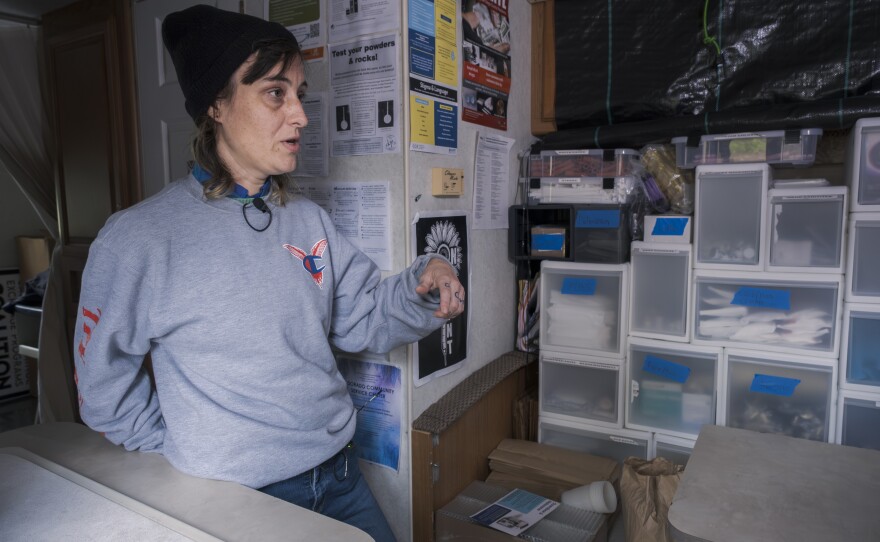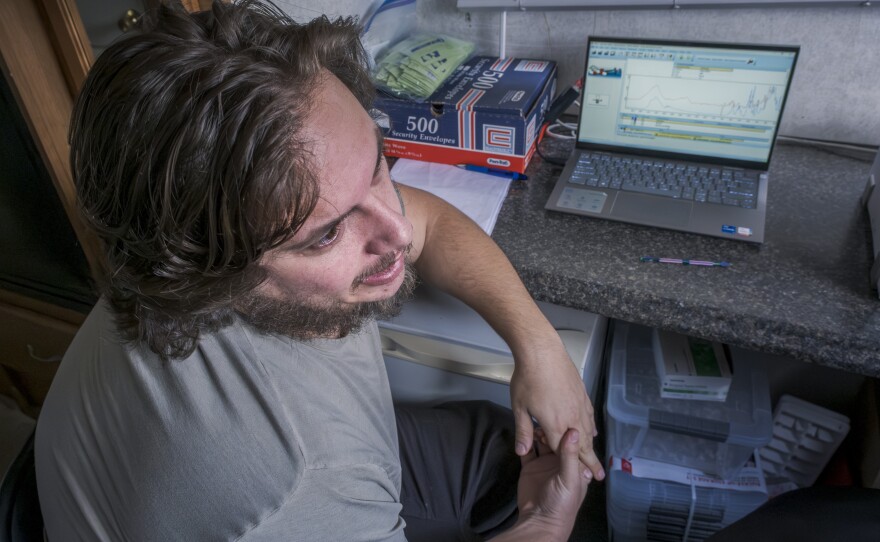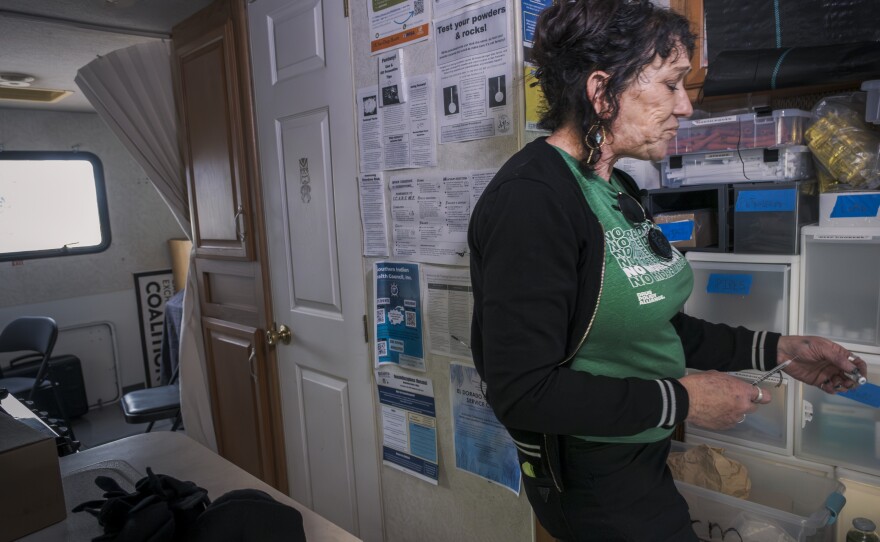A proposed state ballot initiative would make it easier to prosecute overdose deaths as homicides.
Supporters say harsher penalties are needed. Opponents point to unintended consequences and alternatives they say are more effective.
Both sides are scrambling to save lives in a country where overdose has become the leading cause of death for people aged 18-45.
For Matthew Capelouto, the initiative’s main proponent, that’s not just a statistic.

Four years ago, his 20-year-old daughter Alexandra was home in Temecula on Christmas break. He said she had stopped taking her prescribed medication for depression.
“Most people would never know she had these issues,” he said. “She was a straight-A student, had a very high IQ, very quick-witted and a good sense of humor.”
He didn’t know she was seeking other ways to self-medicate.
“I got a call from my youngest daughter saying, ‘Dad, get home. Alex is dead,’” he said.
Capelouto said she bought the painkiller Percocet from a dealer on Snapchat, but the pills were actually fentanyl. She took half of one before bed, he said, and never woke up.
“My daughter did not die of what was originally reported as an accidental overdose,” Capelouto said. “My daughter was poisoned.”
The dealer is serving a nine-year prison sentence. Capelouto said it’s not enough.
He worked with state legislators to propose a law in her name. If someone is convicted of supplying hard drugs — like fentanyl or cocaine — they would receive a warning that says “if they don’t stop and someone dies as a result of their continued action, they could be charged with murder,” Capelouto said.
Alexandra’s Law failed several times to pass through committee at the state legislature. (Capelouto produced a video responding to the senate safety committee’s concerns, which can be viewed here.)
So Capelouto is trying to get it on the ballot to let voters decide.
The initiative includes Alexandra’s Law, and also a mandatory minimum 10-to-12-year sentence for anyone who provides drugs that result in someone’s death.
“I would rather fill our jails than our morgues,” Capelouto said.
District attorneys can already prosecute these deaths as homicides, but this would make it easier. Capelouto said it mirrors a similar warning given for driving while intoxicated.
Jeannette Zanipatin, a lawyer and director of California’s Drug Policy Alliance, said the two can’t be compared.
“We’re setting ourselves up with a slippery slope,” she said.
She said the proposal doesn’t meet the legal standard for homicide of intent. Though Capelouto disputed this idea, industry experts said people who supply drugs often don’t know exactly what’s in them.
“There’s no way to definitively know if what you’re actually selling someone is going to be a lethal dose,” Zanipatin said. “The best way to actually have knowledge and understand what is in the dose is to allow for more drug checking.”

On a late November day in El Cajon, Jes Cochran helped load up San Diego’s Harm Reduction Coalition RV with portable testing strips.
She’s a national harm reduction consultant visiting to observe the program.
“As someone with a pretty extensive lived history with substance use,” she said, “I got really tired of watching my friends die from lack of resources.”
She’s from Indiana, where supplying drugs that result in death is punishable with up to 40 years in prison.
That law was passed in 2018, and Cochran said she witnessed the effects.
She said — and data show — that when neighborhood drug dealers are incarcerated, overdoses increase.
Drug busts don’t reduce the supply, but they do make it more dangerous. People aren’t as familiar with the new dealers or what they’re selling.
Zanipatin said fentanyl is actually a result of the war on drugs, which created demand for something cheaper to produce and easier to transport.
“When those criminalization tactics tend to become more severe, it drives all of that behavior even further underground,” Cochran said.
Cochran said harsher penalties also make users less likely to call for help when someone they’re with overdoses.
“We're seeing even minors being charged, right?” she said. “And these are kids that got a Xanax bar and they gave it to a friend and they didn't know that it had fentanyl in it. And how are they supposed to, right? Like, they're not superheroes. They can't look at something and tell you what the molecular structure of it is.”
Capelouto argued these kinds of cases are rarely prosecuted as homicides. Cochran said the opposite.
Often, she said, the people being charged with homicide are people close to those who died — family or friends, someone who went to the same party or school.

The RV pulled up behind a breakfast diner, where more than a dozen people gathered around tents and cars.
Led by Tara Stamos-Buesig, the team handed out kits with everything from hand sanitizer and beanies to Narcan and pipes.
Some used right in the front of the RV, slumping to the ground.
The team wasn’t phased. They were focused not on ending drug use but on making it safer.
The clean needles and fentanyl test strips they handed out save lives for pennies each.
Team member Jordan Parnes operates a drug testing machine in the back of the RV. He has put about 600 samples through it since September.
He said if opioids are not from a pharmacy, they almost certainly contain fentanyl.
He took a crack at estimating how much it costs annually to run the harm reduction street outreach.
“More than incarcerating one person for a year and less than incarcerating two people for a year,” he said with a wry laugh — about $150,000.

Though white and Black people use and supply drugs at similar rates, Black people are far more likely to be incarcerated for drug-related offenses.
The legislature estimated if passed, the law change would increase costs to the state justice system by tens of millions of dollars, primarily by putting more people in state prison.
Under the decades-long drug war, overdose deaths have continued to climb.
Stamos-Buesig pointed to the 111,000 deaths each year.
“We are having the equivalent of a 747 crashing every day in the United States of people overdosing,” she said.
Harm reductionists, including Cochran and Stamos-Buesig, advocate for more safe consumption sites instead of criminalization.
Just like a bar allows people to use alcohol in a place where someone can keep an eye on them and take their keys if they’re too drunk to go home, and where the supply is regulated, they’d like to see similar sites for hard drugs.

Stamos-Buesig said she and initiative proponent Matthew Capelouto have the same goal. She just doesn’t think his approach will work.
“People aren’t getting a solution in prison,” she said. “That’s not balancing any scale. There is no ‘This takes away from the number of deaths.’”
Californians may see Capelouto’s initiative on clipboards for their signatures.
Capelouto said Congressman Darrell Issa plans to announce a federal version of the legislation on Friday.





